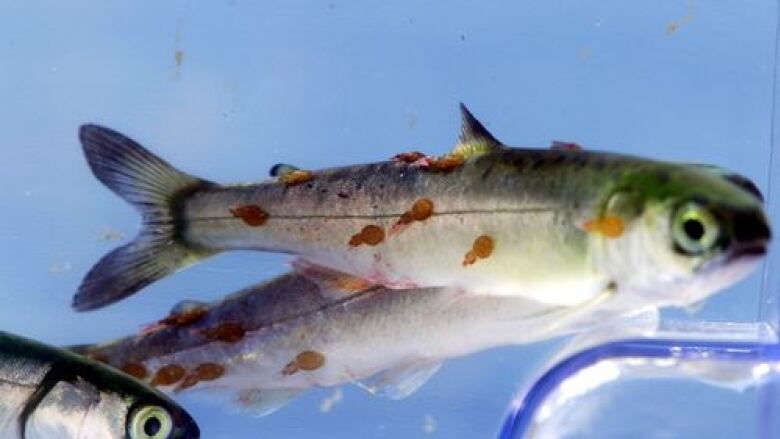Salmon farms should be worried about more than just one species of sea lice, researcher says
PhD candidate says officials only treat based on one species, but second should be considered

Migrating young sockeye salmon that are highly infected with parasitic sea lice grow more slowly, according to a new study from Simon Fraser University researchers.
That matters, the experts said, because growing quickly can be the difference between life and death for vulnerable juvenile salmon.
"Previous studies have shown that to survive to adulthood, young salmon need to get big fast," said Sean Godwin, a PhD student at SFU and lead author on the study.
"Those that grow more slowly — as we found, those heavily infected with sea lice — those fish are more likely to die."
Many people opposed to fish farms have raised concern over declining wild Fraser River sockeye and the potential for parasite transfer from salmon farms.
Wild salmon pass the farming stations as they migrate along the coastline, and lice from the farms can spill into the ocean, latching on to wild sockeye as they go by.
Salmon farms do have measures to monitor and control one species of sea louse, but nearly all the lice found on this study's juvenile salmon were a different species — which isn't targeted in current measures.
- Pressure is on to find out if fish farms make wild salmon sick, says federal scientist
- Sea lice sparks salmon showdown in N.L.
- 2011 study says Wild salmon sea lice linked to B.C. fish farms
Current sea lice treatment protocol
Two species of sea lice off that live off the West Coast are C. clemensi and L. salmonis.
The B.C. Salmon Farmers' Association's treatment regime, set out by the DFO, is only set in motion when L. salmonis numbers get too high. That treatment wipes out C. clemensi, too.
The problem, Godwin said, is that C. clemensi lice can spread unchallenged, so long as L. salmonis numbers are low.
He said those outbreaks have "happened before."
A study published in February found the average number of L. salmonis louse per fish on a B.C. farm was only 2.3 in 2013 — numbers that aren't high enough to raise a red flag.
There were dozens of C. clemensi louse on each of those fish, but those figures wouldn't have triggered treatment.
Godwin noted that it's not proven that the parasites he saw during his study came from fish farms, or that the lice were the direct cause of the slowed growth.
But because there's a chance of that, Godwin said officials should keep that second species in mind.
"I think there is mounting evidence that this species of sea louse that everyone's ignoring ... this species could have real impacts on our wild sockeye."
Parasites 'well controlled,' association says
Jeremy Dunn, executive director with the BCSFA, said L. salmonis is the bigger concern for the association because it affects salmon more often than C. clemensi, which mostly affects herring.
"So, that's been the lice that the DFO has developed the management action around," he said.
He said all farms are required to regularly monitor sea lice levels on their farms and report them to the DFO, which posts the figures online.
Dunn said many farms are "actually unaffected" by C. clemensi and that, overall, parasites are "well managed and well controlled."
When asked about Godwin's study, Dunn said the association considers all kinds of data.
"I think it's an interesting study ... From a management perspective, I think the DFO and farmers are always taking new science into account," he said.
Godwin said he hopes that'll be the case going forward.
"What I hope is that we could start considering this species of sea louse that actually infects our wild juvenile sockeye salmon when making parasite management decisions on salmon farms along the sockeye migration route."
With files from Lisa Johnson